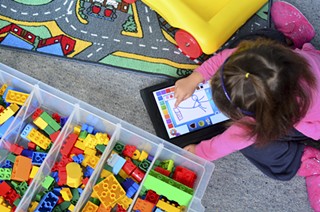Recent headlines have suggested that excessive screen time can be detrimental to the brains of developing children. While there is no parental handbook on how to address screen time issues with your child, an overwhelming body of research can provide guidance.
Screens aren't all bad
Recent research acknowledges that electronics use can play a positive, meaningful role in a child's life if used within healthy limits. Kids now have convenient access to entertainment through digital means. Screens are also commonly used in schools and at home for educational purposes. Screens may allow for creative expression, identity exploration and social engagement and support. In particular, some marginalized teens are finding tremendous social support, exploring strengths and learning more about themselves online.
Screen time comes with risks
Here is the catch: excessive screen time is nearly always harmful. And by excessive, we're talking about four or more hours per day. That's nearly every adult and child with a phone in America. So, what exactly are the risks?
For one, excessive screentime is linked to heightened risk of a variety of mental health concerns, including increased rates of depression, anxiety and suicide. In particular, social media use has been found to be related to a higher risk of self-harming behaviors, eating disorders and lower self-esteem in teen girls. Studies also show a strong correlation between excessive screen time and poor sleep, ADHD-related behavior, eyestrain and even reduced bone density due to less physical activity linked with kids being on their devices more. Excessive screen time has also been correlated with increased conduct issues, drug-related concerns and problems with social skills and real-life support systems.
Neurocognitive differences are found to be associated with excessive screen use. Preschool-age kids (especially boys) who are given devices to calm them tend to have executive functioning problems, including poor focus and self-soothing abilities. Obsessive-compulsive tendencies and behaviors resembling addiction have been noted in kids due to dopamine activity in young brains and the constant homogenous content being experienced over and over.
What should parents do?
For many parents, arguments over limits on phones or other devices may be commonplace.
Removing access to technology is not the answer. In fact, studies have shown that in today's world, that may actually be harmful, too. This may particularly be the case if the child's screen use is primarily providing the positive benefits mentioned above. However, it is recommended that parents put firm limits in place regarding content access and overall screen time to promote responsible management of screen use. As parents, it is necessary that we protect our children from the potential harms of screens, and we simply cannot expect our children – even teens – to be able to do this on their own.
Current screen time recommendations
The American Academy of Pediatrics and Center for Disease Control are great resources for parents looking for age-appropriate guidance for screen time limits. Both recommend two hours a day or less for even the oldest age group. The U.S. surgeon general has recently recommended that parents avoid allowing access to social media until their children are at least age 13. Meanwhile, many social media apps are rated for children as young as 4 years old – talk about a confusing message.
Set limits on your child's device
It is necessary and healthy for parents to have some control over online content and screen time for their children under 18. And the good news is, it is fairly easy to do. First and foremost, parents can prevent exposure to screen time risks by prolonging the purchase of a cellphone for their younger children. In lieu of a phone to deal with, parents can then focus efforts on setting limits on any other device used in the home, such as a smart TV, tablet, gaming device or computer. Parents can use information provided at Protectyoungeyes.com for guidance on setting screen time limits and safety features on nearly any device.
Parents of iPhone or Android phone users can easily set limits using a parental password that allows the parent to control screen time, set application limits, monitor safety and even track location. For iPhone users, this can be done through the "Screen Time" feature under the "Settings" of your child's phone. For Android users, screen time settings can be made using the "Family Link" application.
The current state of our world is digitally-driven, and it is unfair to suggest that kids not engage with screens; however, too much screen time is detrimental. Being in control of screens through reasonable limits leads to screens not being in control of us.
Kelsie Tobias is a licensed clinical social worker and Melissa Fisher Paoni is a licensed clinical psychologist at the Springfield Psychological Center.


















